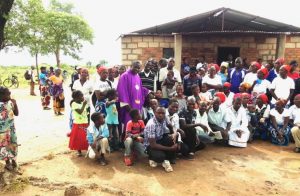Elderly people are the preservers of the historical memory of a community and the carriers of medical knowledge and the secrets of the jungle. A reflection on the threat posed by the Coronavirus pandemic in the Amazon.
The telling of stories passed down from generation to generation is a primary way to communicate wisdom amongst indigenous communities. The elderly people know the origin and the history of their group and narrate it for everyone else, especially on the occasion of ritual greetings.
The older people of indigenous communities transmit, orally, stories and traditions to their children and grandchildren. There are different stories for different places and times. Some stories are narrated during the day, others at night, and others while sitting in a maloca, walking through the mountains or while sailing a canoe.
The older men and women of indigenous communities believe that everything has a reason for its existence and tell the stories about the origin of the world – how water, rain and rivers were formed. These narrations refer to the river-tree or the tree of abundance which, according to indigenous narrations, gave rise to the great Amazon River, to the different types of forests, different trees and thousands of plants and herbs that have healing properties.
The stories about the origins of animals are also very interesting; they are about all different wild animals of the forest and the fish of the water world and their anatomical characteristics, their life cycles, breeding cycles, biogeographic distribution, and the rules concerning hunting and fishing.
The way the elderly speak about their ancestral territory is amazing; they recite, in the form of a litany, hundreds of names of geographic sites of the Amazon basin, beginning with the mouth of the Amazon River and going up the territory, naming site by site through a mental journey that covers thousands of kilometres.
The elderly of indigenous communities have great mastery of shamanism. They use an ancient language to communicate with the spiritual owners of nature and time, with whom they negotiate to fix the disorder of the world or the imbalance in the flow of energy between nature and humans. They operate to maintain world order and avoid over-exploitation of resources, which is a cause of diseases. An older man sitting on a bench, thinking, enjoys the respect of the community, since the elderly continue to heal diseases for the rest of their lives and pass down their knowledge to the next generations.
The elderly of a community are also particularly skilled in the art of building the maloca, because they know its architecture in detail, the types of wood used for its construction, the vines for moorings, the quality of the palms for roofing and many other specifics. They also make artefacts for hunting, fishing and for rituals, which stand out for their colourful feather crowns. Many of the crafts still retain a significance today beyond the strictly utilitarian.
The elders of indigenous communities also master the art of basketry. Woven baskets have different significance depending on the type and pattern of the weaving, which represents the formation of the personality of a young adult. Older indigenous women play an essential role in the community. They are considered as the mothers of abundance and the caretakers of wellbeing. They also master agriculture and food. They have good knowledge of more than a hundred cultivated plants and the nutrients and the light they need to grow. More than 150 varieties of plants and herbs are known in the Colombian Amazon alone.
Older indigenous women also have knowledge of the planting time, the different forms of cultivation, the harvesting calendar, and the seed preservation. They have the agronomic knowledge of an entire system of agriculture in the tropical forest. Their knowledge also includes food transformation; for instance, they are able to convert cassava, which can be poisonous, into a healthy food through the elimination of toxic components.
Older women of the indigenous communities also know how to use plants and herbs for the cure of diseases according to shamans’ prescriptions. Indigenous grandmothers know old stories, tales and ritual songs which they narrate and teach to their grandchildren transmitting to them, by doing so, passing on the myths, legends, traditions of their culture.
These women are also very skilled in the art of pottery. They are responsible for the manufacturing of pots, trays and a whole set of artefacts made of clay. They know the characteristics of each type of clay, and what to do and to add in to improve their consistency. They also master the ceramic burning techniques, the type of firewood used, the firing and colouring processes, and know the methods to make ceramics shine. Older indigenous women make ceramic artefacts for daily life and rituals.
The elderly play an essential role in indigenous communities. When we lose an older person we lose a library, we lose mastery, traditions and culture. In these times of COVID-19, it is necessary to take care of indigenous communities, to guarantee their isolation in order to protect them and support their self-care, especially that of the elderly as they are the most susceptible individuals and the key group for cultural survival and the biocultural memory of humanity.
(Carlos Rodríguez)






